测量重力加速度实验Acceleration due to gravity
单摆实验中g的公式
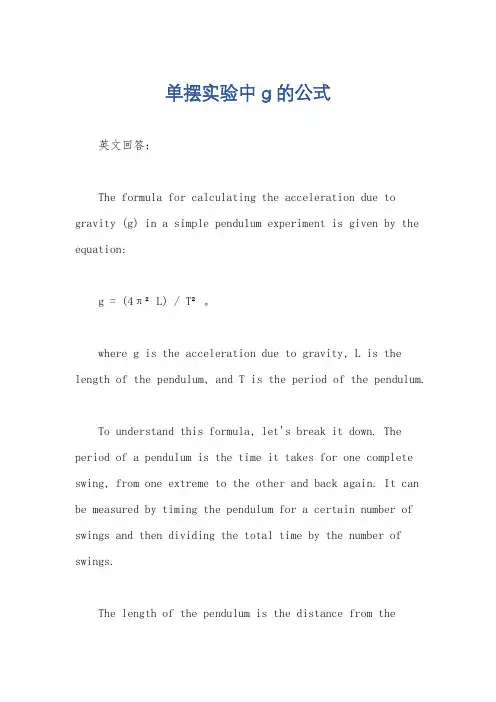
单摆实验中g的公式英文回答:The formula for calculating the acceleration due to gravity (g) in a simple pendulum experiment is given by the equation:g = (4π²L) / T²。
where g is the acceleration due to gravity, L is the length of the pendulum, and T is the period of the pendulum.To understand this formula, let's break it down. The period of a pendulum is the time it takes for one complete swing, from one extreme to the other and back again. It can be measured by timing the pendulum for a certain number of swings and then dividing the total time by the number of swings.The length of the pendulum is the distance from thepoint of suspension to the center of mass of the pendulum bob. It is usually measured from the point of suspension to the bottom of the bob.The formula shows that the square of the period is directly proportional to the length of the pendulum. This means that if the length of the pendulum is increased, the period will also increase. Similarly, if the length of the pendulum is decreased, the period will decrease.The formula also shows that the square of the period is inversely proportional to the acceleration due to gravity. This means that if the period of the pendulum increases, the acceleration due to gravity will decrease. Conversely, if the period of the pendulum decreases, the acceleration due to gravity will increase.By measuring the period of a pendulum of known length, we can calculate the acceleration due to gravity using the formula. For example, if we measure the period of a pendulum with a length of 1 meter and find it to be 2 seconds, we can plug these values into the formula tocalculate the acceleration due to gravity.中文回答:单摆实验中计算重力加速度(g)的公式如下:g = (4π²L) / T²。
测量重力加速度的简易方法
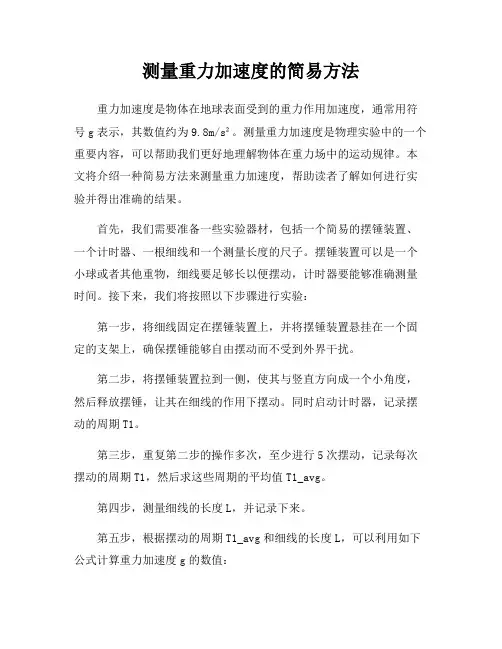
测量重力加速度的简易方法重力加速度是物体在地球表面受到的重力作用加速度,通常用符号g表示,其数值约为9.8m/s²。
测量重力加速度是物理实验中的一个重要内容,可以帮助我们更好地理解物体在重力场中的运动规律。
本文将介绍一种简易方法来测量重力加速度,帮助读者了解如何进行实验并得出准确的结果。
首先,我们需要准备一些实验器材,包括一个简易的摆锤装置、一个计时器、一根细线和一个测量长度的尺子。
摆锤装置可以是一个小球或者其他重物,细线要足够长以便摆动,计时器要能够准确测量时间。
接下来,我们将按照以下步骤进行实验:第一步,将细线固定在摆锤装置上,并将摆锤装置悬挂在一个固定的支架上,确保摆锤能够自由摆动而不受到外界干扰。
第二步,将摆锤装置拉到一侧,使其与竖直方向成一个小角度,然后释放摆锤,让其在细线的作用下摆动。
同时启动计时器,记录摆动的周期T1。
第三步,重复第二步的操作多次,至少进行5次摆动,记录每次摆动的周期T1,然后求这些周期的平均值T1_avg。
第四步,测量细线的长度L,并记录下来。
第五步,根据摆动的周期T1_avg和细线的长度L,可以利用如下公式计算重力加速度g的数值:g = 4π²L / T1_avg²通过以上步骤,我们就可以利用简易的摆锤装置测量重力加速度的数值。
需要注意的是,在实验过程中要尽量减小误差,例如确保摆锤装置的摆动角度较小、细线的长度准确等。
另外,进行多次实验并求平均值可以提高结果的准确性。
总之,测量重力加速度是物理实验中的一项基础实验,通过简易的摆锤装置和一些基本的实验器材,我们可以很好地完成这一实验并得出准确的结果。
希望本文介绍的方法能够帮助读者更好地理解重力加速度的概念,并在物理学习中有所帮助。
水龙头如何利用重力加速度测试原理?
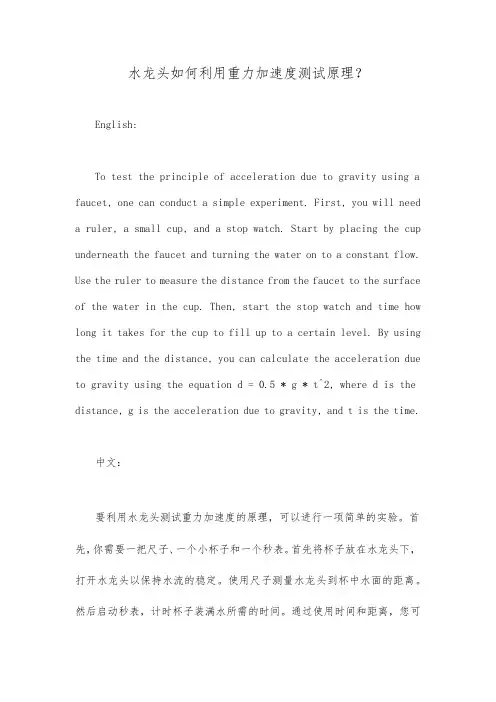
水龙头如何利用重力加速度测试原理?English:To test the principle of acceleration due to gravity using a faucet, one can conduct a simple experiment. First, you will need a ruler, a small cup, and a stop watch. Start by placing the cup underneath the faucet and turning the water on to a constant flow. Use the ruler to measure the distance from the faucet to the surface of the water in the cup. Then, start the stop watch and time how long it takes for the cup to fill up to a certain level. By using the time and the distance, you can calculate the acceleration due to gravity using the equation d = 0.5 * g * t^2, where d is the distance, g is the acceleration due to gravity, and t is the time.中文:要利用水龙头测试重力加速度的原理,可以进行一项简单的实验。
首先,你需要一把尺子、一个小杯子和一个秒表。
首先将杯子放在水龙头下,打开水龙头以保持水流的稳定。
使用尺子测量水龙头到杯中水面的距离。
然后启动秒表,计时杯子装满水所需的时间。
通过使用时间和距离,您可以使用方程式 d = 0.5 * g * t^2 来计算重力加速度,其中 d 是距离,g 是重力加速度,t 是时间。
自由落体实验方程式
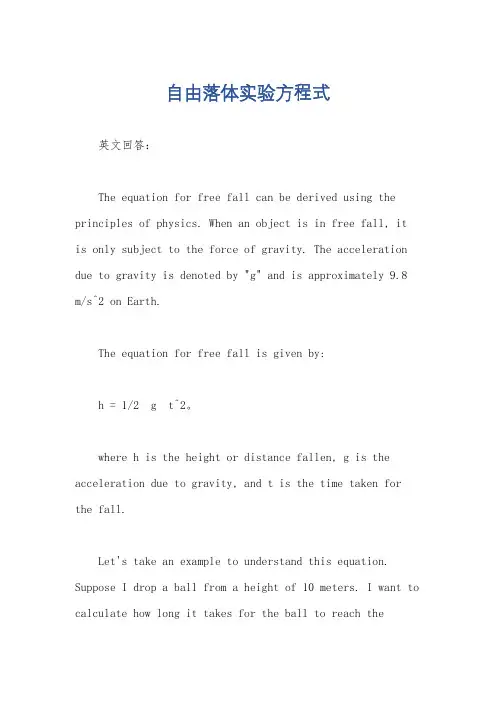
自由落体实验方程式英文回答:The equation for free fall can be derived using the principles of physics. When an object is in free fall, itis only subject to the force of gravity. The acceleration due to gravity is denoted by "g" and is approximately 9.8 m/s^2 on Earth.The equation for free fall is given by:h = 1/2 g t^2。
where h is the height or distance fallen, g is the acceleration due to gravity, and t is the time taken for the fall.Let's take an example to understand this equation. Suppose I drop a ball from a height of 10 meters. I want to calculate how long it takes for the ball to reach theground.Using the equation for free fall, we can rearrange it to solve for time:t = √(2h/g)。
Substituting the values, we get:t = √(2 10 / 9.8) ≈ √2 ≈ 1.41 seconds.Therefore, it takes approximately 1.41 seconds for the ball to reach the ground when dropped from a height of 10 meters.中文回答:自由落体实验方程式可以通过物理原理推导得出。
初中物理 Direction of acceleration due to gravity
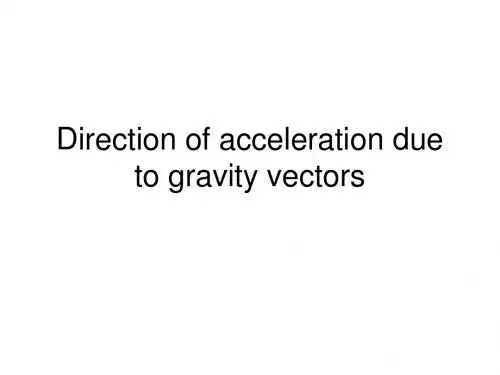
• On your whiteboards, draw the direction of acceleration for the following objects.
• The dashed line represents its path.
• * not drawn to scale
#1. A pebble dropped from a bridge *
#1. A pebble dropped from a bridge
*
The vector is oriented down.
#2. A baseball tossed up in the air, halfway up the path
*
#2. A baseball tossed up in the air, halfway up the path *
#6. A cannonball rolling off a table *
#6. A cannonball rolling off a table *
The vector is oriented down.
• What can you summarize about the direction of the vector representing acceleration of all these objects?
Direction of acceleration due to gravity vectors
• *
Acceleration due to gravity is a vector quantity.
• Vectors can be represented by an arrow to show magnitude and direction
用阿特伍德机测量重力加速度
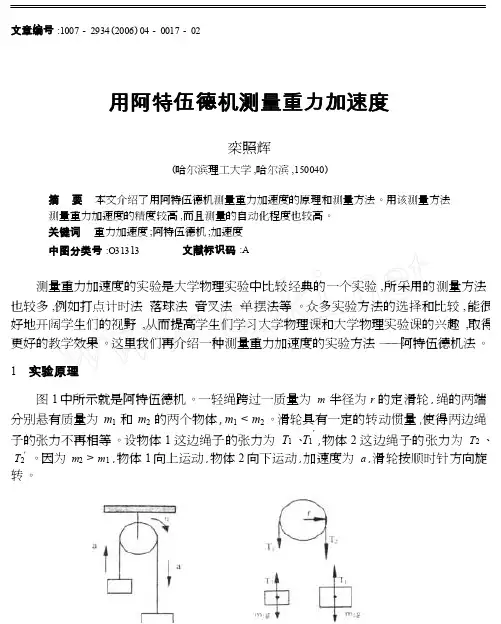
文章编号:1007 - 2934 (2006) 04 - 0017 - 02用阿特伍德机测量重力加速度栾照辉(哈尔滨理工大学,哈尔滨,150040)摘要本文介绍了用阿特伍德机测量重力加速度的原理和测量方法。
用该测量方法测量重力加速度的精度较高,而且测量的自动化程度也较高。
关键词重力加速度;阿特伍德机;加速度中图分类号:O31313 文献标识码:A测量重力加速度的实验是大学物理实验中比较经典的一个实验,所采用的测量方法也较多,例如打点计时法、落球法、音叉法、单摆法等。
众多实验方法的选择和比较,能很好地开阔学生们的视野,从而提高学生们学习大学物理课和大学物理实验课的兴趣,取得更好的教学效果。
这里我们再介绍一种测量重力加速度的实验方法———阿特伍德机法。
1 实验原理图1 中所示就是阿特伍德机。
一轻绳跨过一质量为m 半径为r 的定滑轮, 绳的两端分别悬有质量为m1 和m2 的两个物体, m1 < m2 。
滑轮具有一定的转动惯量,使得两边绳′子的张力不再相等。
设物体1 这边绳子的张力为T1 、T1 ,物体2 这边绳子的张力为T2 、′T2 。
因为m2 > m1 , 物体1 向上运动, 物体2 向下运动, 加速度为 a , 滑轮按顺时针方向旋转。
T1 - m1 g = m1 a m2 g - T2 = m2 a T1 = T1′, T2 = T2′T2′r- T1′r= Jα式中J 为滑轮的转动惯量, J = 1mr2 ;α是滑轮转动的角加速度,滑轮边缘上的切向2加速度与物体的加速度相等, 即有:a = αr从以上各式可解得:m1 + m2 + 1 m 2g = am2 - m1我们在已知m 、m1 、m2 的情况下,可以通过实验测量出两物体的加速度 a , 代入公式即可较精确地求出重力加速度g 。
2 实验方法及装置本实验的设计装置中采用了电脑通用计数器。
该仪器用光电输入口采集数据信号, 以单片微机为中央处理器处理数据, 最后用数码管显示各种测量结果。
测量重力加速度实验报告
本次实验旨在通过单摆法测量重力加速度,加深对简谐运动和单摆理论的理解,并掌握相关实验操作技能。
二、实验原理单摆在摆角很小时,其运动可视为简谐运动。
根据单摆的振动周期T和摆长L的关系,有公式:\[ T^2 = \frac{4\pi^2L}{g} \]其中,g为重力加速度。
通过测量单摆的周期T和摆长L,可以计算出当地的重力加速度。
三、实验仪器1. 铁架台2. 单摆(金属小球、细线)3. 秒表4. 米尺5. 游标卡尺6. 记录本四、实验步骤1. 将单摆固定在铁架台上,确保摆球可以自由摆动。
2. 使用游标卡尺测量金属小球的直径D,并记录数据。
3. 使用米尺测量从悬点到金属小球上端的悬线长度L,并记录数据。
4. 将单摆从平衡位置拉开一个小角度(不大于10°),使其在竖直平面内摆动。
5. 使用秒表测量单摆完成30至50次全振动所需的时间,计算单摆的周期T。
6. 重复步骤4和5,至少测量3次,取平均值作为单摆的周期T。
7. 根据公式 \( g = \frac{4\pi^2L}{T^2} \) 计算重力加速度g。
1. 小球直径D:\(2.00 \, \text{cm} \)2. 悬线长度L:\( 100.00 \, \text{cm} \)3. 单摆周期T:\( 1.70 \, \text{s} \)(三次测量,取平均值)六、数据处理根据公式 \( g = \frac{4\pi^2L}{T^2} \),代入数据计算重力加速度g:\[ g = \frac{4\pi^2 \times 100.00}{(1.70)^2} \approx 9.78 \,\text{m/s}^2 \]七、误差分析1. 测量误差:由于测量工具的精度限制,如游标卡尺和米尺,可能导致测量数据存在一定误差。
2. 操作误差:在实验过程中,操作者的反应时间、摆动角度的控制等因素也可能导致误差。
八、实验结论通过本次实验,我们成功测量了当地的重力加速度,计算结果为 \( 9.78 \,\text{m/s}^2 \)。
重力加速度 英语
重力加速度的英语翻译是 "acceleration due to gravity"。
以下是一些双语例句:
1. The acceleration due to gravity on Earth is approximately 9.8 meters per second squared.(地球上的重力加速度约为每秒9.8米)
2. The acceleration due to gravity determines the rate at which objects fall to the ground.(重力加速度决定了物体下落到地面的速度)
重力加速度 英语
3. The acceleration due to gravity varies depending on the planet or celestial body.(重力加速度根据行星或天体的不同而有所变化)
4. The acceleration due to gravity can be calculated using the formula g = G * M / R^2, where G is the gravitational constant, M is the mass of the celestial body, and R is the distance from the center of the body.(重力加速度可以使用公式 g = G * M / R^2 进行计算,其中 G 是万有引力常数,M 是天体的质量he acceleration due to gravity is responsible for keeping objects on the surface of the Earth.(重力加速度使物体能够保持在地球表面)
重力加速度的测定实验报告
重力加速度的测定实验报告实验报告:重力加速度的测定摘要:本实验旨在通过自由落体实验法和双摆实验法分别测定重力加速度,并比较两种方法的实验结果。
实验结果表明,两种方法分别得到的重力加速度值为9.77 m/s²和9.79 m/s²,精度较高且符合理论值9.81 m/s²。
因此,本实验中所使用的两种方法均可以用于重力加速度的测定。
实验介绍:本次实验采用了自由落体实验法和双摆实验法两种方法对重力加速度进行了测定。
自由落体实验法的原理为在重力作用下物体做自由竖直上抛运动的运动方程为:h=1/2*g*t²。
双摆实验法的原理为,当两个摆长相等的摆锤在同一时刻由于受到重力作用而做简谐运动时,它们的解释周期相等。
周期T与摆长l和重力加速度g有关系式T=2π√(l/g)。
实验步骤:1.自由落体实验法:(1)测量掉落高度h,取三个值,求平均值。
(2)打开计时器,记录物体下落的时间t,取三个值,求平均值。
(3)根据t=sqrt(2h/g)计算测得的重力加速度g的值。
2.双摆实验法:(1)调整两个摆的长度,使它们长度相等,然后分别测量其振动的周期T1、T2,取平均值T。
(2)根据T=2π√(l/g)计算测得的重力加速度g的值。
实验结果:自由落体实验法分别测得的重力加速度值为9.77 m/s²、9.84m/s²、9.73 m/s²,平均值为9.78 m/s²;双摆实验法得到的重力加速度值为9.79 m/s²。
两种方法得到的重力加速度值精度较高,均符合理论值9.81m/s²。
而自由落体实验法所测得的重力加速度值略低于理论值,可能是由于空气阻力和实验误差导致的。
实验结论:通过自由落体实验法和双摆实验法分别对重力加速度进行测定,可以得到精度较高,均符合理论值的结果。
虽然自由落体实验法所测得的结果略低于理论值,但是仍可以用于初步的重力加速度测定。
小谢尔顿中英对照剧本第一季第二十集
S01E20It was a beautiful morning in East Texas.那那那那那那那那那那那那那The kind of morning that made you want to get up,那那那那那那那那get dressed and test that acceleration due to gravity那那那那那那那那那那那does not depend on an object's motion.那那那那那那那那那那那那那I love Saturdays.那那那那那那The Earth causes the same gravitational acceleration of everything,那那那那那那那那那那那那那那那那那那那even a doll and a flying Ping-Pong ball.那那那那那那那那那那那It's not often a man of science那那那那那gets to say "Yippee ki-yay," and mean it, but...那那那那那那那那"那那那"那...Yippee ki-yay.那那那Morning, Herschel.那那那那那Hey, George. Uh, you didn't see a dog那那那那那那那那那wandering around here, did you?那那那那那那那那No. Y'all get a dog?那那那那那那那Uh, sort of. We took him in after my brother-in-law那那那那那那那那那那那那那那had to go live in a gated community.那那那那那那那那那Oh, that sounds nice; uh, they got a no pets policy?那那那那那那那那那那那那那那He's in jail, George.那那那那那那Right, sure.那那那In physics, nothing feels better than predicting an outcome.那那那那那那那那那那那那那那那那那那那那I love predictability.那那那那那那The force of gravity: predictable.那那那那那Nuclear fusion: predictable.那那那那那那My brother peeing in the shower:那那那那那那那那那repulsive, but predictable.那那那那那那那What isn't predictable:那那那那那那那那dogs.那I've always been terrified of dogs.那那那那那那那那To me, they're nothing but big, furry question marks.那那那那那那那那那那那那那那那那那Question marks with teeth.那那那那那那In panic situations, I'd often lose consciousness.那那那那那那那那那那那那那This time, I only lost my voice.那那那那那那那那那那Help.那那Please help.那那那那♪ Nobody else is stronger than I am ♪♪ 那那那那那那那那 ♪♪ Yesterday I moved a mountain ♪♪ 那那那那那那那那 ♪♪ I bet I could be your hero ♪♪ 那那那那那那那那那那 ♪♪ I am a mighty little man ♪♪ 那那那那那那那那那那 ♪♪ I am a mighty little man ♪♪ 那那那那那那那那那那 ♪Uh, I was just admiring那那那那那那Grandpa Smurf's unique walking stick.那那那那那那那那Smurf-a-loo-loo.那那那那那那That's not my walking stick.那那那那那那那Lunch is ready.那那那那Can you go get your brother?那那那那那那那那那那那I'm watching TV.那那那那那那Just go.那那I have to do smurfing everything around here.那那那那那那那那那那那那那那I heard that.那那那那I said "smurfing."那那那那"那那那那"And I heard how you said it.那那那那那那那那那那那She can cut her own crusts off.那那那那那那那那那那那Sheldon?那那那Who are you?那那那那You're so cute.那那那那Be careful.那那那What are you doing up there?那那那那那那那那Staying alive.那那那那Whose dog is this?那那那那那那I don't know. Get help.那那那那那那那那那那Well, how did he get into the garage?那那那那那那那那那Please get help.那那那那那那那那那Maybe we can keep it.那那那那那那那那那I'm begging you, get help now.那那那那那那那那那First, I have to tell you something.那那那那那那那那那那What?那那Lunch is ready.那那那那Will you look at that?那那那What kind of dog chews through wood?那那那那那那那那那Y'all are feeding him, right?那那那那那那那Maybe he's teething.那那那那那那那You know, when Billy was little,那那那那那那he chewed right through his playpen.那那那那那那那那- No kidding? - Only had three teeth.-那那那那-那那那那那那Mostly gummed it.那那那那那那那那那So how y'all want to fix it?那那那那那那那那那那Well, I figure I'll patch it,那那那那那那那那那那run some chicken wire along the bottom-- 那那那那那那那那那那那那那that way, he don't chew through it again.那那那那那那那那那那那那那Hello.那那那- Hey. - Hey, Billy.-那那-那那那那那Was this fence window always here?那那那那那那那那那那那那那No, son, that's a new fence window.那那那那那那那那那那那那那Anybody else getting dizzy?那那那那那那那Why didn't you call for help?那那那那那那那那那I tried, but no sound came out.那那那那那那那那那那那You poor thing.那那那那那It was very dirty up there.那那那那那那那Is cleaning the garage your job or Dad's?那那那那那那那那那那那那那Don't you worry about that.那那那那那那那Here, have some tea.那那那那- Chamomile? - Yes.-那那那那-那那One teaspoon of honey?那那那那那那那那那Yes.那那An ice cube to cool it off?那那那那那那那那那那那I went with two today.那那那那那那那You've been through enough.那那那那那那那那I prefer one ice cube.那那那那那那那那那那那Drink it.那那那那那那It's nice when the kids are in bed,那那那那那那那那那那那and we can just hang out and relax.那那那那那那那那那那那I'm not even gonna respond to that.那那那那那那那那那那I finally got him asleep.那那那那那那那He's still pretty shook up.那那那那那那那那Maybe having this mutt next door won't be so bad.那那那那那那那那那那那那那那那Shelly could end up getting used to it.那那那那那那那那那那那那That's true.那那那那那Remember when he got all freaked out那那那那那那那那那by the fruit at the bottom of yogurt?那那那那那那那那那那那那那Now he eats it no problem.那那那那那那那那那He still makes me stir it.那那那那那那那那那那那那那Maybe you could start out那那那那那那那那那with a small pet, and work your way up.那那那那那那那那那那那那那那Like a turtle.那那那那那He says they carry salmonella.那那那那那那那那那那A gerbil?那那那Apparently, they caused the plague.那那那那那那那那那那那那那What about a bird?那那那Oh, I know that one.那那那那那They'll steal his hair to make a nest.那那那那那那那那那那那Mom!那At least this time, sound came out.那那那那那那那那那那那I call that progress.那那那那那那那那What's going on?那那那Your dog got into our house.那那那那那那那那那那How the hell did he do that?那那那那那那He pushed in a screen window.那那那那那那那那You think he chewed through the fence again?那那那那那那那那那那那那那那All I know is Sheldon's yelling at the dog,那那那那那那那那那那那那and Mary's yelling at me.那那那那那那那Now I'm looking at you in your underwear.那那那那那那那那那那那那那Damn it, Herschel, what is going on?那那那那那那那那那Oh, hey, George.那那那那那Hey, Brenda.那那那那那那Bucky got in their house.那那那那那那那那那That's funny.那那那那那It might be funny one day, not right now.那那那那那那那那那那那那那那那那那Look, I'm real sorry, George.那那那那那那那那I'll keep him tied up, it won't happen again.那那那那那那那那那那那那那Y'all have a good night.那那那那George!那那You are not gonna believe this. Look.那那那那那那那那那Their dog left a dead squirrel in our living room.那那那那那那那那那那那那那那那那Well, h-he is part hunting dog.那那那那那那那I think that means he likes you.那那那那那那那那那那I'm not interested in winning his affection.那那那那那那那那那那I'm interested in keeping dogs and rodents outside of my home.那那那那那那那那那那那那那那那那那Well, now, hold on.那那How do we know it was Bucky that left那那那那那那那那that squirrel in your house?那那那那那那那那那那Maybe that squirrel was already there.那那那那那那那那那那那那那Why else would a dead squirrel be in my living room?那那那那那那那那那那那那那那那那I don't know what kind of house you keep.那那那那那那那那那那那那My house is immaculate.那那那那那那George, tell them. Uh...那那那那那那那She does keep a nice house.那那那那那那那那那那那Honey, it's a pretty good chance it was Bucky.那那那那那那那那那那那那那那- Whose side are you on? - Yours, always yours.-那那那那那-那那那那那那那All right. Everyone's upset, it's late.那那那那那那那那那那那那那那那那Maybe we should drop this for tonight?那那那那那那那那那那那That's a good idea. Okay.那那那那那You just keep your dog away from my son.那那那那那那那那那那那那那- There you go picking it up again. - I am sorry,-那那那那那那那-那那but their dog broke into our home.那那那那那那那那那那那那那Something he probably learned from your brother.那那那那那那那那那How dare you.那那那那那那Okay, I think that's a good stopping point.那那那那那那那那那那那那那How do we know that your son didn't那那那那那那那那那那那lure Bucky in to perform weird science experiments on him?那那那那那那那那那那那那那那那那那那那My son was asleep in his bed, and you have some nerve...那那那那那那那那那那那那那那那那那...Night, George!那那那那那Night!那那I don't understand why that dog那那那那那那那is so interested in Sheldon.那那那那那那那那那Maybe Bucky likes the way Sheldon smells?那那那那那那那那那那那那Your brother washes himself three times a day.那那那那那那那那那He has no smell.那那那那那Here we go: animal control.那那那那那那那那Oh, no, no.那那No, you don't want to go calling animal control.那那那那那那那那那那那那那那那- Why not? - Because,-那那那那那-那那you have to live next door to these people.那那那那那那那那那那那那They called the cops on Georgie when he played music too loud.那那那那那那那那那那那那那那那那那那Maybe it was them, maybe it was me.那那那那那那那那那那Anyway, the point is,那那那那you don't can't go throwing gasoline on the fire.那那那那那那那那那那那那Well, they started this fire,那那那那那那那那and now, they're gonna get burned.那那那那那那那那那I believe you've had enough coffee.那那那那那那那那那那那那那那Listen, why don't you let me talk to Brenda,那那那那那那那那那那那那那那and just smooth things out?那那那那那那那那Why do you think she'll listen to you?那那那那那那那那那那那那Because people like me more than you.那那那那那那那那那那那那那People like me.那那那那那那I didn't say they don't, they just like me more.那那那那那那那那那那那那那那那Anyway, I see her all the time at bowling.那那那那那那那那那那那那那I know how to handle her.那那那那那那那那那Fine.那Thank you.那那Plenty of people like me.那那那那那那那那那Hey, Brenda, how's it going?那那那那那那那Your daughter's a pain in my ass, that's how it's going.那那那那那那那那那那那那那You don't beat around the bush.那那那那那那那那那那那I've always liked that about you.那那那那那那那那那Connie, I've had a long night.那那那那那那那那那那Unless you're looking to bowl, I don't want to hear it.那那那那那那那那那那那那那那那那Aw, now, come on.那那那那那Let me buy you a drink, and we'll talk about this.那那那那那那那那那那那那那I'm more on your side than you think.那那那那那那那那那那那- Somehow, i doubt that. - It's true.-那那那那那那那那-那那那Don't you think I realize that Mary can be a bit...那那那那那那那那那那那那那那那...Of a self-righteous bitch?那那那那那那那那那I was gonna say "challenging," but sure, let's go with yours.那那那那那"那那那"那那那那那那那那It's got a nice rhythm.那那那那那那那Brenda, this is, by far,那那那那那那那那the best bowling alley margarita in town.那那那那那那那那那那那那那那那那那那那How long you and Herschel been married? 18, 19 years?那那那那那那那那那那那1819那那那19, but it feels like 30.19那那那那30那那Well, y'all are a great couple.那那那那那那那那那那I just wanted to thank you那那那那那那for being so patient and kind to my daughter and her family那那那那那那那那那那那那那那since they moved in.那那那那那那那那那- It's nothing. - No, it needs to be said.-那那那那-那那那那那那You know, Mary has a tough job raising those three kids,那那那那那那那那那那那那那with one of them being, you know, somewhat special.那那那那那那那那...那那那- I can see that. - Yeah.-那那那那-那那And having a kind neighbor makes all the difference in the world.那那那那那那那那那那那那那Well, we try.那那那那那那And I know you know how stressful it is,那那那那那那那那那那那那那seeing as how you have your own child那那那那那那那who is special in his own way.那那那那那那What's that supposed to mean?那那那那那那那Well, I mean, hey, I know Billy is a terrific little boy,那那那那那那那那那那那那but I am sure he has presented you and Herschel那那那那那那那那那那那那那with some challenges.那那那那If there's a weird kid in the neighborhood,那那那那那那那那那那那那那it's your grandson.那那那那那那那Now, hang on, I said "special," not "weird."那那那那那那那"那那"那那"那那"I heard you.那那那那I said "weird."那那那那"那那"Okay, see now, Brenda,那那那那那那you don't want to go calling my grandson weird 那那那那那那那那"那那"when I've just treated you to a margarita grande.那那那那那那那那那那那那那那那Well, I'm sorry, but you shouldn't be inferring 那那那那那那那那那那那there's something wrong with my Billy.那那那那那那那Darlin', there's no inferring.那那那那那那I've seen the boy sitting in the dirt那那那那那那那那那那那eating his own belly button lint.那那那那那那那那那Really, Mom? This is how you put out the fire?那那那那那那那那那那那那那Well, at least she got the worst of it.那那那那那那那那How you figure that?那那那那那那那那那I ripped a big patch of hair out of her head.那那那那那那那那那那那那那This will be healed in a week.那那那那那那那那She will be wearing a hat till Labor Day.那那那那那那那那那那那那那那I want to be just like you when I grow up.那那那那那那那那那- No, you don't. - Pick again.-那那-那那那Excuse me, Ms. Hutchins?那那那那那那那那那Hey, Sheldon.那那那那那Can you recommend any books on overcoming phobias?那那那那那那那那那那那That's in the self-help section.那那那那那那那那那Follow me, I have read them all.那那那那那那那那- Any phobia in particular? - Dogs.-那那那那那那那那-那Ah, cynophobia. That's a good one.那那那那那那那Did you know there's over 50 million dogs那那那那那那那just in the United States alone?那那那那5那那那那那That's 50 million too many.那那那5那那那那Here. I read this one to help with my haphephobia.那那那那那那那那那那那那那那那Ah, fear of being touched. I have that, too. Was it useful?那那那那那那那那那那那那那那Well, when someone's interested in touching me,那那那那那那那那那we'll find out.那那那那The basic premise of the book was that phobias那那那那那那那那那were overcome by taking incremental steps那那那那那toward confronting the phobia in question.那那那那那那那那那In my case, that started with watching a TV show那那那那那那那那那那that was adored by children around the world,那那那那那那那那那but for me, was the stuff of nightmares.那那那那那那那那那那那那那那Scooby-Doo!那那那The next step was to go face-to-face那那那那那那那那那那with real dogs.那那那Albeit through a plate-glass window.那那那那那那那那那那Okay, that's enough.那那那那And finally,那那a close encounter of the third kind,那那那那那那那那physical contact with a member of the canine species.那那那那那那那那那那那那那Hello, I'd like to speak with the veterinarian.那那那那那那那Well, I was hoping you might have one or two dogs 那那那那那那那那那那那那那那那那under anesthesia that I might come by and pet.那那那那那那那Sure, I'll hold.那那那那那Who are you talking to?那那那那那那那The Medford Veterinary Clinic.那那那那那那那Why?那那那I'm trying to overcome my fear of dogs那那那那那那那那那那before it affects our family any further.那那那那那那那那那那那那Oh, honey, you don't have to worry about how it affects us.那那那那那那那那那那那那那Meemaw got punched in the face because of me.那那那那那那那那那那那那那那No, that wasn't because of you, and for the record,那那那那那那那那那那那your meemaw gets punched in the face all the time.那那那那那那那那那那Well, I still think I need to take那那那那那那那那some sort of positive action.那那那那那那那那- Hello? - Yes, hello?-那-那那那Oh, that's too bad.那那那How about a small fluffy one that's recently died of old age?那那那那那那那那那那那那那Enough.那那Sorry.那那Now, it says here in Mark 12:31那那那那那那12那31那那那that you should "Love your neighbor as yourself.""那那那那那"Anybody like to take a guess what that means? Missy?那那那那那那那那那那那那那那It means to be nice to the people who live next door.那那那那那那那那那That's right.那那But everybody else can go to hell.那那那那那那那那那那那那那Okay, Missy, we don't use that kind of language here.那那那那那那那那那那那那And if you think about it, in this world,那那那那那那那那那那那那那with all the ways we can travel, everybody's your neighbor.那那那那那那那那那那那那那那那那那那那Yes, Sheldon.那那那How do we love our neighbors那那那那那那那那那when our moms hate each other?那那那那那那那那那那那那- Who does your mom hate? - Your mom.-那那那那那那-那那那Hey, my mom hates your mom. Small world.那那那那那那那那那那那那Okay, let's hang on a second.那那那那那那My mom also hates their grandma.那那那那那那那那那那那'Cause she lost a fight to her.那那那那那那那那那Nuh-uh, she won. She said so.那那那那那那那那All right, stop. Let's stop.那那那那那那Now this might be hard to understand,那那那那那那那but living a loving, Christian life那那那那那那那那那那那isn't always the easiest thing to do.那那那那Yes, Billy.那那My mom's not crazy about you either.那那那那那那那那那Just love your neighbor, 'kay?那那那那那那那那Now, I am more than willing to look the other way那那那那那那那那那那那那when my parishioners don't get along with each other.那那那那那那那那那那That sort of thing happens, but when it becomes a problem 那那那那那那那那那那那那那那那那for the children, then I have to intervene.那那那那那那There's no problem here,那那那那那other than these two thinking that they're better than me.那那那那那那那那那那那那那I don't think it, I know it.那那那那那那那那I gave your mother a good smacking.那那那那那那那那I can give you one, too.那那那那那那那那那那That's big talk from somebody with a comb-over.那那那那那那那那那那那那那那那那Ladies.那那那Do I need to remind you that we are Christians?那那那那那那那那那那那那那那那In all our behavior, in all our actions,那那那那那那那那那那那we must constantly ask ourselves the question,那那那那那那那那那那那"What would Jesus do?""那那那那那那"Can I say something?那那那那那那Would Jesus say it?那那那那那那那Never mind.那那In my life,那那那那那I've often been accused of being a physical coward,那那那那那那那那那那那and for the most part, those accusations are correct.那那那那那那那那那那那But there have been times when I've shown great courage.那那那那那那那那那那那那那那This was one of them.那那那那那那那Hello, Bucky.那那那那那Are you a good dog?那那那那那那Please be a good dog.那那那那那那Please.那那那Now oftentimes, when we don't like someone,那那那那那那那那那那那what's happening is we see something in them那那那那那那那那那那那那那那那那that we don't like in ourselves.那那那那那那那那What are you saying?那那那那那Really? That was over your head?那那那那那那那那那I'm saying,那那那y'all might have more in common than you think.那那那那那那那那那那那那那那Well, don't say both their kids are "special."那那那那那那那那那那那"那那"She does not like that.那那那那那那那那Okay.那那Here we go.那那Petting... the dog.那那...那那I'm doing it.那那那那I'm petting a dog.那那那那那I've conquered my phobia.那那那那那那那那You're a good boy. Yes, you are.那那那那那那那那那I'm sorry for the unkind things I said to you.那那那那那那那那那那那那Me, too.那那那Connie?那那What?那那Anything you'd like to say?那那那那那那Not particularly.那那那Mom.那那Okay.那那I'm sorry for the things I said,那那那那那那那那and, you know, what happened at the bowling alley.那那那那那那那那那那那那那那As am I.那那那Here.那I think this came out of your head.那那那那那那那那那那那那那He licked me! He licked me!那那那那那那那那The dog licked my tongue!那那那那那那那那那I can still taste it!那那那那那那那那那Call 911!那那那那那那I think Jesus might go check that out.那那那那那那那那那那那那How's it going in there, baby?那那那那那那那那那那Okay, but we're gonna need more Listerine.那那那那那那那那那那那那那I'm proud of him for trying to overcome that damn dog phobia.那那那那那那那那那那那那You should tell him that.那那那那那那那Well, if he ever leaves that bathroom, I will.那那那那那那那那那那那那What I can't figure out is why that dog is so drawn to Sheldon.那那那那那那那那那那那那那那那那那那那Beats me.那那那那- You say his owner's in the slammer? - Yeah.-那那那那那那那那那那那那-那那Wonder what kind of fella he is.那那那那那那那那那那It's a mystery.那那那那I guess we'll never know.那那那那那那那那那那那Hey, Moonpie.那那那I got you a little something to help you那那那那那那get over your fear of animals.那那那那那那那那那那A tranquilizer gun?那那那那A pet fish.那那那那那那Why?那那那Well, I thought you could start small and then work your way up.那那那那那那那那那那那那那那那Look, he's kind of cute.那那那那那那He doesn't even care that I'm here. I like him.那那那那那那那那那那那那那那What are you gonna name him?那那那那那那那Fish.那Fish?那那I'm not ready to get attached.那那那那那那那那那那Fish are kind of boring.那那那那那I know, isn't it great?那那那那那那那那那But you can't even pet 'em.那那那那那那那Maybe we can.那那那那那Baby, what's wrong?那那那那那那那I tried to pet Fish! Ah, he was so slimy!那那那那那那那那那那那那Well, yeah, he's a fish.那那那那那那I put my finger in the top of the tank, then I touched him,那那那那那那那那那那那那那那and he bit me!那那那那那Oh, I'm sure he didn't bite you.那那那那那那那那I can't breathe.那那那那那那His fish blood is mixing with my human blood.那那那那那那那那那那那那那那那那- Maybe he was just trying to give you a kiss. - No. -那那那那那那那那那-那He hates me. I never want to see him again.那那那那那那那那那那那那Oh, Sheldon, you're being silly.那那那那那那那Fish like this don't bite.那那那那那那那那Look. See? He's harmless.那那那那那那那Son of a bitch!那那那那Dad killed my fish!那那那那那那那George!那那He'll be fine.那那那那那那Just got to put him back in the bowl.那那那那那那那那那Oh, George.那那。
- 1、下载文档前请自行甄别文档内容的完整性,平台不提供额外的编辑、内容补充、找答案等附加服务。
- 2、"仅部分预览"的文档,不可在线预览部分如存在完整性等问题,可反馈申请退款(可完整预览的文档不适用该条件!)。
- 3、如文档侵犯您的权益,请联系客服反馈,我们会尽快为您处理(人工客服工作时间:9:00-18:30)。
Acceleration due to gravity1. Aim:To measure ‘g’, the acceleration due to gravity using a simple pendulum.2. Theory:A simple pendulum consists of a particle of mass m, attached to a frictionless pivot P by a cable of length L and negligible mass. When the particle is pulled away from its equilibrium position by an angle θand released, it swings back and forth as Figure 1 shows. By attaching a pen to the bottom of the swinging particle and moving a strip of paper beneath it at a steady rate, we can record the position of the particle as time passes. The graphical record reveals a pattern that is similar (but not identical) to the sinusoidal pattern for simple harmonic motion.Figure 1 A simple pendulum swinging back and forth about the pivot P. If the angle θis small, the swinging is approximately simple harmonic motion.Gravity causes the back-and-forth rotation about the axis at P. The rotation speeds up as the particle approaches the lowest point and slows down on the upward part of the swing. Eventually the angular speed is reduced to zero, and the particle swings back. If the angle of oscillation is large, the pendulum does not exhibit simple harmonic motion. The motion of a simple pendulum is nearly simple harmonic. The periodic time T is related to the length L of the pendulum and the local acceleration due to gravity g.2T=or224T Lgπ⎛⎫= ⎪⎝⎭If we measure the periodic time T for different lengths L, and plot T2 versus L,we should get a straight line that passes through the origin. The graph will have slope24g π⎛⎫= ⎪⎝⎭. Thus, by measuring the slope of the graph we can determine g. 3. Procedure:(a) Tie a thread to a pendulum bob. Pass the other end of the thread through the hole of the fixed device on the retort stand. And adjust the pendulum overhangs the graduated scale. The length of the pendulum is adjusted by the regulating screw on the fixed device and fixed by the locking screw on it.(b) Place a graduated scale with several vertical marks on it under the pendulum so that when the latter is at rest it aims one of the vertical marks from an observer in front of the pendulum.(c) Set the pendulum bob swinging through a small arc, using the large protractor as a guide. Check that the swing is in a vertical plane. Restart the bob if the swing is elliptical. A ‘small’ arc means less than 5○ or that the amplitude of swing is always less than one tenth of the length of the pendulum being used.Figure 2 The instrument structure.(d) Choose five lengths e.g. 0.45, 0.50, 0.55, 0.60 and 0.65 m are satisfactory. It is not necessary to adjust the lengths to those exact values. The length used should however be measured accurately - measure from the lower face of the hole of the fixed device to the centre of the bob.(e) For each length, make three determinations of the time required for 50 complete swings. Count ‘zero’ a s the bob passes the vertical marker and 1, 2, 3 etc. as the bob passes the marker again while going in the same direction. Average these three time values and calculate the time (periodic time) for one complete swing (oscillation). Tabulate the results in your report.4. Results:Plot T2 as a function of L. Obtain an average value of2TLfrom the slope of the graph. When drawing the graph ensure that the points are evenly spread on both sides of the line.Figure 3 How to get the slope.A is any point on the graph and AB is perpendicular to the L axis.2T ABslope AverageL OB==Calculate ‘g’ from:224g ms slopeπ-=The value of g on the Earth's surface varies from point to point because of several effects:(a) The Earth is not spherical (it is more closely an oblate spheroid); (b) The Earth is rotating;(c) The distribution of mass density in the Earth is not homogeneous; (d) The Moon and Sun exert tidal accelerations; (e) etc., etc...The nominal value of g on a smooth Earth, taking into account oblateness and rotation is, at sea level:()2429.7803110.00528sin 0.00002sin /g m s ϕϕ=++where ϕ is the latitude of the location. The latitude of FUZHOU UNIVERSITY is approximately 26.08︒.Use this information to calculate the value of g at FUZHOU UNIVERSITY, and compare this calculated figure with the value you have measured.5. Conclusions:In no more than 100 words write a succinct summary of what you have done. State the goal and method of the experiment. State your main results, i.e.: What value did you get for the acceleration due to gravity? Is your result in agreement with the accepted value? If your result is not consistent with the accepted value can you suggest why not?。
